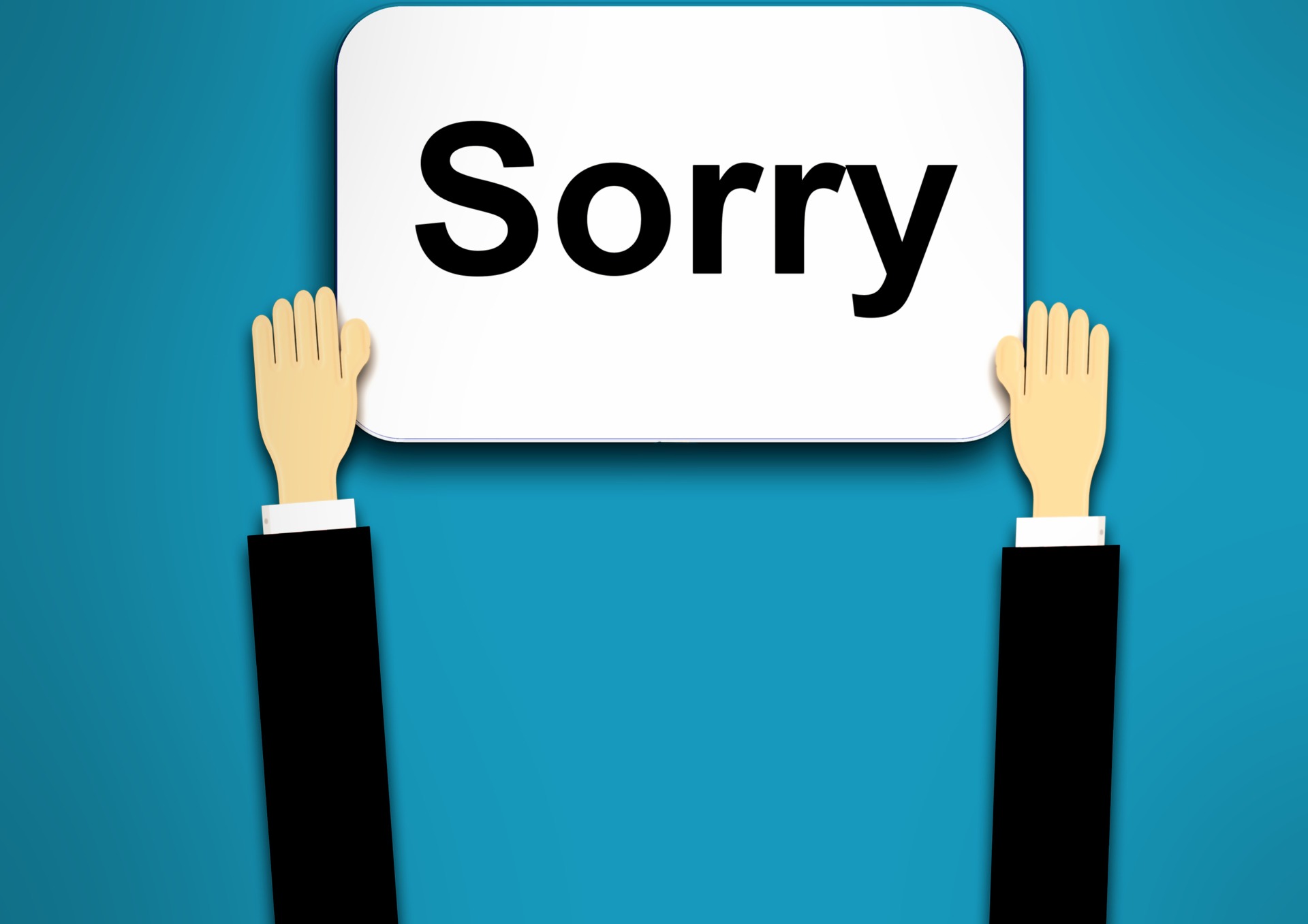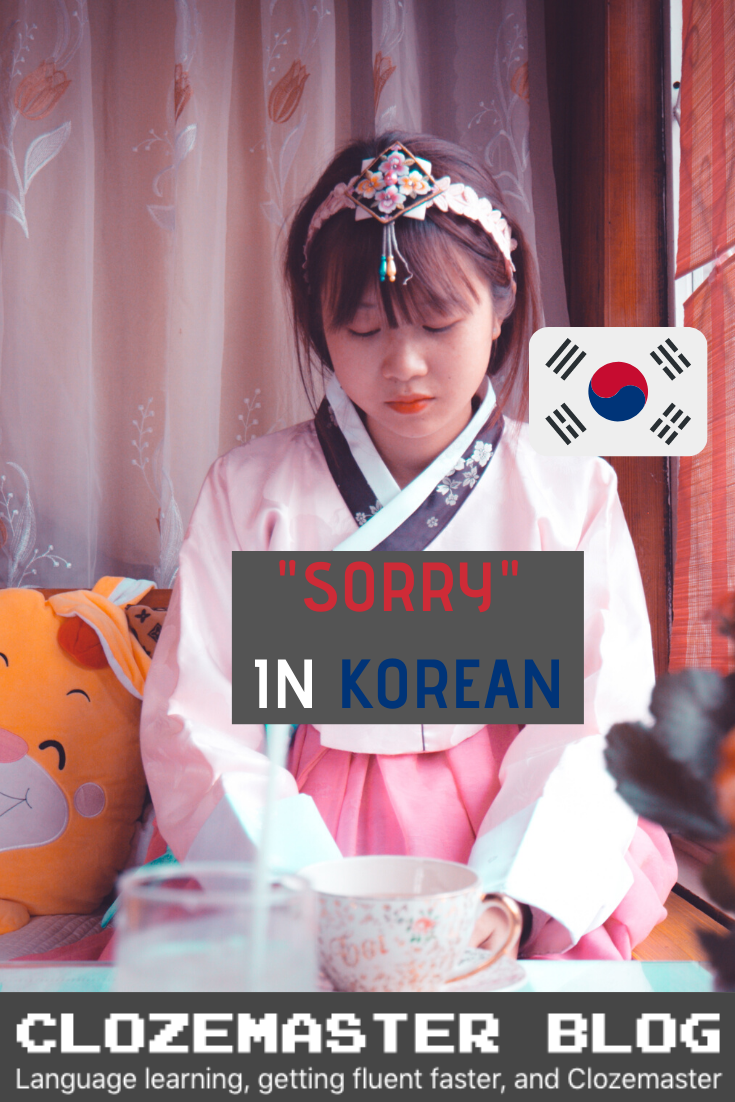
We use the word ‘sorry’ in so many different ways in English. The most common way is to apologize for something we have done, but we also say sorry to express sympathy, disappointment, and also to politely ask someone to repeat what they have said. Fortunately, ‘sorry’ in Korean isn’t as multi-functional. Nevertheless, there are a number of different ways of saying sorry in Korean, and in this article, we’ll guide you through all the different ways of saying ‘sorry’ in Korean so that you can say ‘sorry’ appropriately in every situation.
“Sorry” in Korean is a verb
Sorry in English is an adjective, so to say ‘sorry’, we use the verb ‘to be’ and say ‘I am sorry’. However, in Korean ‘sorry’ is a verb.
- 미안하다 (mi-an-ha-da)
미안하다 is a verb that means ‘to be sorry’, and this is made up of the noun 미안 (mi-an) which means ‘sorry’ and the verb 하다 (ha-da), which means ‘to do’.
When we say ‘I’m sorry’ in Korean, we don’t use the pronoun ‘I’. If we’re saying sorry on someone else’s behalf, then we need to say who we’re saying sorry for. However, in general, the context makes it obvious that it’s the speaker that’s apologizing, so we can just use the verb 미안하다.
미안하다 is the base form, so we can conjugate this verb into three levels of formality.
The formal form of “sorry” in Korean
- 미안합니다 (mi-an-ham-ni-da)
We use the formal form 미안합니다 in very formal situations, such as when you’re apologizing to senior people at your workplace, or when you’re apologizing to much older members of the family. Generally, the formal form is not commonly used in everyday speech.
The polite form of “sorry” in Korean
- 미안해요 (mi-an-he-yo)
The polite form is what you will use the most in everyday life. When you accidentally bump into people, when you step on someone’s foot accidentally, and when you knock over someone’s coffee, you can say 미안해요. We use 미안해요 to people we are not familiar with, and with people who are older than us and in more senior position than us.
If you ever need to say sorry in Korean, 미안해요 is the one that can be used in most situations, so you should familiarize yourself with this expression.
The casual form of “sorry” in Korean
- 미안해 (mi-an-he)
Casual expressions are mainly used with two types of people – close friends, and close family members. However, it’s important that the close family members are of similar age to you as you shouldn’t say 미안해 to family members who are older than you. In general, we would use the casual form to our siblings and our cousins.
Honorific form of “to be sorry’” in Korean
Sometimes in Korean, we have an entirely different form of the same word, which we use to be even more respectful than the formal form of the original word. For example, the common verb for ‘to give’ is 주다 (ju-da), but the honorific form is 드리다 (deu-ri-da), and the common verb for ‘to sleep’ is 자다 (ja-da), but the honorific form is 주무시다 (ju-mu-shi-da).
Now, similarly, the common verb for ‘to be sorry’ is 미안하다, but the honorific form is…
- 죄송하다 (jwe-song-ha-da)
Like 미안하다, 죄송하다 is made up of the noun 죄송 (jwe-song), which means ‘sorry’, and the verb 하다 which means to do.
죄송하다 is the base form, and we can conjugate this into formal and polite forms.
We use the formal form 죄송합니다 if we’re in very formal situations, such as in job interviews, and people who work in the service industry regularly use this formal form when apologizing to the customers.
We use the polite form when we’re apologizing to people who are older than us or are in a more senior position than us in organizations. We also use 죄송해요 when apologizing to people who we’ve met for the first time.
Difference between 미안하다 & 죄송하다
To illustrate the differences between 죄송해요 and 미안해요, if a 40-year-old man accidentally steps on a 16 year-old kid’s foot, then the man would say 미안해요 to apologize as even though the boy is much younger than the man, the man still needs to maintain politeness as he doesn’t know the boy.
On the other hand, if the same man accidentally steps on another man’s foot, who seems about the same age, then the man will likely apologize by saying 죄송해요, as not only do they not know each other, there is the possibility that the other man is older than him, so the man has to use respectful language. In fact, in this situation, the man may even apologize by using the formal form 죄송합니다.
What if we’re “really sorry”?
More often than not, we don’t just say ‘I’m sorry’, we often say things like ‘I’m so sorry’ or ‘I’m really sorry’ to emphasize how sorry we are. And although the Korean 미안하다 and 죄송하다 aren’t adjectives like ‘sorry’, we can still use modifiers to highlight how sorry we are. First, we can say ‘I’m really sorry’, like this.
- Formal – 정말 미안합니다. (jung-mal mi-an-ham-ni-da)
- Polite – 정말 미안해요. (jung-mal mi-an-he-yo)
- Casual – 정말 미안해. (jung-mal mi-an-he)
The world 정말 (jung-mal) means ‘really’ and it can be used to modify all three forms of sorry, 미안하다. We can also use 정말 with the formal and polite forms of 죄송하다, so we can say…
- Formal – 정말 죄송합니다. (jung-mal jwe-song-ham-ni-da)
- Polite – 정말 죄송해요. (jung-mal jwe-song-he-yo)
In Korean, there are two words for ‘really’, 정말 and 진짜 (jin-jja), and you can use 진짜 instead of 정말 in all these phrases.
“I’m so sorry” in Korean
To say ‘I’m so sorry’, we can say:
- Formal – 너무 미안합니다. (neo-mu mi-an-ham-ni-da)
- Polite – 너무 미안해요. (neo-mu mi-an-he-yo)
- Casual – 너무 미안해. (neo-mu mi-an-he)
너무 (neo-mu) can mean ‘so’ or ‘too’, and we can use them to further highlight how sorry we are. We can also 너무 with the formal and polite form of 죄송하다, so we can say…
- Formal – 너무 죄송합니다. (neo-mu jwe-song-ham-ni-da)
- Polite – 너무 죄송해요. (neo-mu jwe-song-he-yo)
“Apology” and “Apologize” in Korean
We’ve already learned two nouns that means sorry, 미안 and 죄송. However, There is another word in Korean that means apology, and it’s 사과 (sa-gwa). 사과 is also the word for ‘apple’ in Korean, but it’s other meaning is apology. The verb that means ‘to apologize’ is 사과하다 (sa-gwa-ha-da). If we want to ask someone to apologize, then we can say…
- Formal (Please apologize) – 사과하세요. (sa-gwa-ha-se-yo)
- Polite (Please apologize) – 사과해요. (sa-gwa-he-yo)
- Casual (Apologize) – 사과해. (sa-gwa-he)
All three sentences mean either ‘Please apologize’ or ‘Apologize’,
Honorific form of “to apologize” in Korean
Similar to how there was an honorific form of 미안하다, which was 죄송하다, there is also an honorific form of 사과하다. However, instead of changing 사과 with another noun, we change 하다 to the honorific form of the verb ‘to give’ 드리다 (deu-rida), which we saw earlier in this article.
We use 사과드리다 when we talk about apologizing to someone who we need to be respectful to. So if we’re talking about apologizing to someone much older or in a much more senior position than us, then we would use 사과드리다 instead of 사과하다.
To ask someone to apologize in a respectful way, we conjugate the 사과드리다 in the following way.
- Formal (Please apologize) – 사과드리세요. (sa-gwa-deu-ri-se-yo)
- Polite (Please apologize) – 사과드려요. (sa-gwa-deu-ryeo-yo)
- Casual (Apologize) – 사과드려. (sa-gwa-deu-ryeo)
An important point to note is that we don’t use the honorific form 사과드리다to ask someone to apologize to us, but we use these expressions when the other person needs to apologize to someone they need to be respectful to.
Wrap Up!
So in this article, we looked at all the different ways of saying ‘sorry’ in Korean. The standard verb for ‘to be sorry’ is 미안하다, and it can change into three levels of formality.
- Formal – 미안합니다 (mi-an-ham-ni-da)
- Polite – 미안해요 (mi-an-he-yo)
- Casual 미안해 (mi-an-he)
The honorific form is 죄송하다 and we can conjugate this into three levels of formality.
- Formal – 죄송합니다 (jwe-song-ham-ni-da)
- Polite – 죄송해요 (jwe-song-he-yo)
Then we learned to use modifiers 정말 & 진짜 meaning ‘really’ and 너무 meaning ‘so’ with 미안하다 and 죄송하다, so we can then like this.
- Formal – 정말 미안합니다 (jung-mal mi-an-ham-ni-da)
- Polite – 너무 미안해요 (neo-mu mi-an-he-yo)
Finally, we learned that the noun ‘apology’ is 사과 and the verb to apologize is 사과하다. And the honorific form of ‘to apologize’ is 사과드리다. To ask the other person to apologize, we can say:
- Formal (Please apologize) – 사과하세요. (sa-gwa-ha-se-yo)
- Polite (Please apologize) – 사과해요. (sa-gwa-he-yo)
- Casual (Apologize) – 사과해. (sa-gwa-he)
And to ask the other person to apologize to someone they need to be respectful to, then we can say:
- Formal (Please apologize) – 사과드리세요. (sa-gwa-deu-ri-se-yo)
- Polite (Please apologize) – 사과드려요. (sa-gwa-deu-ryeo-yo)
- Casual (Apologize) – 사과드려. (sa-gwa-deu-ryeo)
Now that you’ve learned all the different expressions to say ‘sorry’ in Korean, it’s time to put into practice what you learned in this article in real life situations. However, if that’s not possible, then practice these expressions with the Clozemaster app.
오늘도 수고하셨어요! Great job today! See you next time.
Learn Korean in context with ClozemasterClozemaster has been designed to help you learn the language in context by filling in the gaps in authentic sentences. With features such as Grammar Challenges, Cloze-Listening, and Cloze-Reading, the app will let you emphasize all the competencies necessary to become fluent in Korean. Take your Korean to the next level. Click here to start practicing with real Korean sentences! |



Great post
This is amazing, I learn a lot here thank youuuu😊